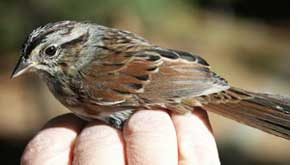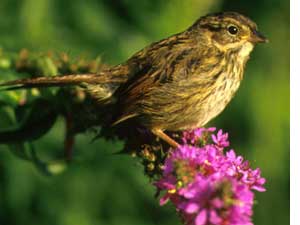 |
 |
|
 |
 |
 |
 |
 |
|
 |
 |
 |
 |
'Vocal Learners' make noise at MBL
By Jonathan Talbot
Songbirds a preferred model to study speech acquisition and development
Squid. Mouse. Surf clam. Sparrow. Sea snail. Freshwater zebrafish. Giant sea slug. If you think it would be easy to pick out the organisms starring in research this summer at the Marine Biological Laboratory, think again. In truth, all of these animals play key roles in summer projects. MBL, it seems, is not just for marine organisms anymore.
 Songbirds, for example, are not a traditional model for neurobiology research at the MBL, which made the squid giant axon famous. Yet summer researchers Michale Fee of Lucent Technologies and Richard Mooney of the Duke University Medical Center say that the tradition of neurobiology at MBL, combined with Woods Hole's summer draw for the best neurobiologists in the world, makes it the perfect place for the two to study learning and memory in the swamp sparrow. The MBL thought the match so good that it awarded both neurobiologists Dart Fellowships, along with David Glanzman, who is studying learning and memory in Aplysia. Songbirds, for example, are not a traditional model for neurobiology research at the MBL, which made the squid giant axon famous. Yet summer researchers Michale Fee of Lucent Technologies and Richard Mooney of the Duke University Medical Center say that the tradition of neurobiology at MBL, combined with Woods Hole's summer draw for the best neurobiologists in the world, makes it the perfect place for the two to study learning and memory in the swamp sparrow. The MBL thought the match so good that it awarded both neurobiologists Dart Fellowships, along with David Glanzman, who is studying learning and memory in Aplysia.
"It's intriguing to me that 50 years ago, this was the place to do neuroscience, because everybody who wanted to do neurophysiology needed a marine organism to do it," says Mooney. "For a while that was supplanted by other approaches. Interestingly, people are gravitating back because of tradition here, and I think it speaks to the commonality of the mechanisms involved."
Neurobiologists refer to songbirds such as canaries, cardinals, and mockingbirds as "vocal learners." Vocalization plays a critical role in courtship for these birds, who must hear the songs before they can generate the complex and varied songs themselves. Songbirds also need to hear themselves sing to maintain their songs. It's a rare form of learning also found in humans, whales, and bats, but few other animals.
Such similarities with human learning and production of speech have made songbirds a preferred model to study speech acquisition and development, particularly how hearing sounds relates to the ability to produce them, and how the brain controls respiration and vocal organs.
To unravel the mysteries of song learning and vocalization in songbirds, researchers Fee and Mooney record the electrical activity of individual brain neurons while birds sing. They have chosen the swamp sparrow, Melospiza georgiana, native to the Eastern United States, for their research this summer, in large part because this species has long served as the focus for classical behavioral studies in song learning and in song recognition, and so has a reasonably well-understood nervous system. The summer project tests the idea that different populations of premotor neurons are recruited to produce different song types.
"Traditionally, resolving the activity of single neurons has required anesthetized preparations," says Mooney. "Of course, once an animal is under anesthesia, about the only behavior it produces is respiration. It certainly doesn't sing, and anything less than the whole living bird will not work, either."
 Recent advances in the minitiaturization of electronics, including progress made by Fee, now allow him to attach a featherweight device to a bird's head, and then record electrical activity from selected individual neurons in an area of the brain known as the HVc, or hyperstriatum ventralis pars caudalis, while the bird is in a fairly natural setting. Recent advances in the minitiaturization of electronics, including progress made by Fee, now allow him to attach a featherweight device to a bird's head, and then record electrical activity from selected individual neurons in an area of the brain known as the HVc, or hyperstriatum ventralis pars caudalis, while the bird is in a fairly natural setting.
The swamp sparrow, like other songbirds, produces several distinct songs, and seems to recognize and respond to them as distinct sounds. "We want to know how these brain areas are active during the utterance of different songs," says Mooney,
Adding to the complexity of the research is the relatively small size of the neurons in the bird's brain: the cell body diameter is typically less than 20 microns, compared to 100 microns or more in various invertebrate ganglia. The "microdrive" device allows the researchers to remotely select which tiny neuron is recorded without disturbing the bird.
"Everyone has had the experience of approaching a singing bird and having it go quiet," says Mooney. "For this research, it is critical that the bird is not only awake but relaxed enough to actually sing."
The second part of the songbird project tests the idea that a given subpopulation of these neurons are both active during a vocalization and stimulated by the auditory presentation of that same vocal sound. "We want to see if there is an equivalence of auditory and motor activity in this area," says Mooney, "which might be one way in which the nervous system facilitates auditory-vocal interactions important to learning song."
To finely resolve which neurons are being recorded, Mooney and Fee use a method known as ‘antidromic stimulation,’ in which action potentials are propagated from the axons of recorded neurons backwards up axons to cell bodies, where they are recorded by electrodes.
Auditory-guided vocal learning is found in both humans and birds, though they do not share a common ancestor who was a vocal learner, explains Mooney. In this sense, bird song is an analogue to human learning of speech, a case of convergent evolution that requires young animals to learn by hearing to achieve the ability to vocalize as an adult.
Even if the exact strategies are not used in birds and humans, Mooney says, the exact same problem is solved by the bird as in the human infant, of achieving a very high-order transformation from sensory to motor representations of the vocalization.
Fee and Mooney believe their research will shed light on all kinds of sequenced movements where many different kinds of activities have to be coordinated, including speech.
The research by Mooney and Fee should eventually open new doors to clinical treatment for problems of speech perception and production, but may also shed light on various disorders which make other sequenced action difficult, such as Parkinson's disease and various choreiform disorders.
On a more profound level, Mooney suggests, the ability to perceive sequences of movements or sounds may underlie our ability to appreciate music, but may also provide part of the ability to think. "The ability to generate or anticipate these sequences may be a form of thought, and may ultimately be a necessary prerequisite for consciousness," he says.
|
| |

 |
|
 |
 |
|